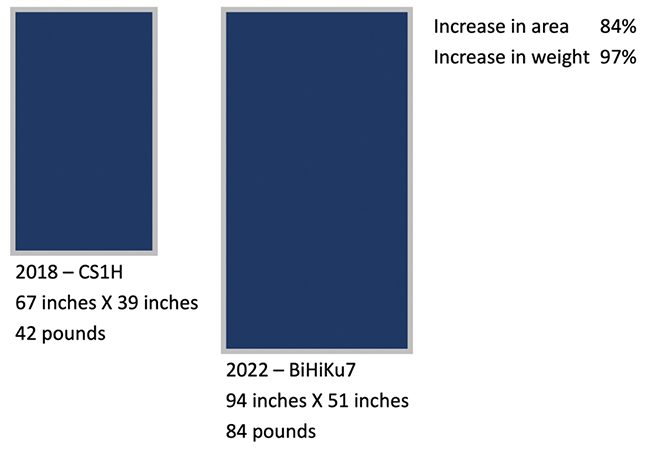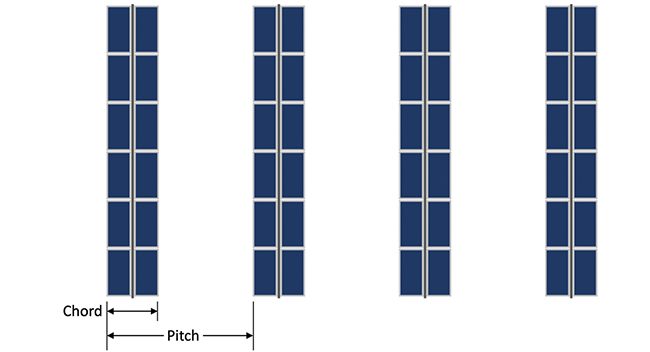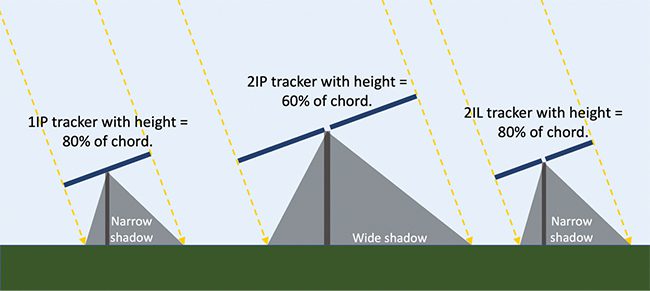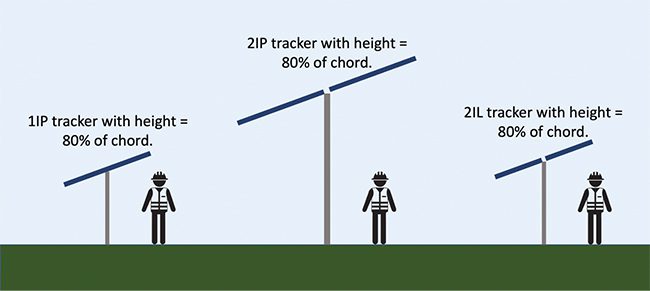Tracker Configurations for Bifacial Modules Support Distributed Generation Sites
Industry trends toward bigger and heavier modules, along with greater adoption of bifacial technology, are changing the way designers of solar power sites are thinking about tracking systems.
Distributed generation (DG) photovoltaic (PV) power plants are an important part of the global energy mix. DG plants provide clean energy at low cost, and they can be developed, planned, built, and commissioned within a short period of time, providing a quick response to growing demand.
In most of the U.S., the economics of DG power plants require the use of single-axis trackers, so tracker selection is critical to the success of distributed generation. Two strong industry trends—bigger and heavier modules, and wide adoption of bifacial technology—are causing designers of DG plants to think differently about trackers. Those factors are among those we’ll explore in this article to evaluate three types of single-axis trackers.
Module Technology Trends
Commercial solar modules have become larger and heavier in recent years. As an example, Figure 1 compares two modules made by Canadian Solar—one widely used in 2018, and the other widely used today. Today’s modules are nearly twice as big in area, and nearly twice as heavy, compared with modules from just a few years ago.
 |
|
1. Module size increase from 2018 to 2022, based on the manufacturer’s data sheets. Source: Canadian Solar |
Today’s modules are also increasingly bifacial—that is, they produce energy by converting light that strikes both sides of the modules. This trend could reverse, if U.S.-made thin film modules gain market share due to domestic content concerns. But now and for the foreseeable future (Figure 2), designers of DG power plants are mostly designing with large bifacial modules, and trackers need to be selected with that in mind.
 |
|
2. Expected growth of bifacial technology. Source: Adapted from International Technology Roadmap for Photovoltaic, March 2022, VDMA |
Types of Single-Axis Trackers
The most common type of tracker used in DG projects is the one-in-portrait (1IP) design. These 1IP trackers (Figure 3) mount modules to a single torque tube, or to two purlins, extending north-south, so the long sides of each module run east-west. 1IP trackers are supplied to DG projects in North America by several manufacturers, including Array Technologies, FTC Solar, GameChange Solar, NEXTracker, OMCO Solar, and Solar FlexRack, and they are familiar to construction companies, who have installed them for more than 10 years.
|
3. Single-axis tracker configurations. Courtesy: OMCO Solar |
Two-in-portrait (2IP) trackers are less common, and are supplied by several tracker manufacturers including FTC, GameChange, and Soltec. These 2IP trackers mount pairs of modules to a torque tube, or to two north-south purlins, with the long sides of the modules running east-west.
|
4. A two-in-landscape tracker. Courtesy: OMCO Solar, photo by Andrew Ballentine |
Less common are two-in-landscape (Figure 4), or 2IL, trackers, which mount pairs of modules, with the long sides of each module extending north-south, parallel to the torque tube or purlins. At the moment only OMCO Solar has commercialized 2IL trackers in North America.
Choosing Trackers for a DG Power Plant
Tracker cost is a major factor in technology selection, including posts, structure, controllers, and other components delivered to the site. 1IP trackers are generally the lowest cost, with 2IL slightly higher, and 2IP significantly more expensive. The high cost of 2IP trackers is due to structural materials such as foundations, torque tubes or purlins, and module mount brackets.
A second consideration is each tracker’s ability to withstand high winds. 1IP and 2IL trackers are lower to the ground, and present less surface area to the wind, compared with 2IP trackers. 2IP trackers are higher and present more module surface to the wind, especially at times when the trackers are at high angles—shortly after sunrise and shortly before sunset. That means 2IP trackers can present higher risk of a destructive wind event over the life of the DG power plant.
 |
|
5. Chord and pitch. Courtesy: OMCO Solar |
A third consideration is land use. In the east-west dimension, the layout of a PV plant will vary based on tracker configuration, but the ratio between the pitch and the chord (Figure 5) should be the same for all tracker configurations—for example, it might be 3:1. So all these configurations will provide approximately equal land use in the east-west dimension.
But in the north-south dimension, three factors can separate trackers. First is whether there are gaps over the posts to allow bearings to protrude above the plane of the modules. Many 1IP trackers have such gaps, often about 15 inches wide, and they reduce ground coverage ratio (GCR); but light passing through those gaps may increase energy production slightly.
A second consideration in the north-south dimension is tracker length. Longer trackers mean fewer gaps between trackers in the north-south dimension, which means better GCR.
Third is the ability of each tracker to follow terrain in the north-south direction. 2IP trackers are shorter than 1IP or 2IL trackers, so they can follow terrain better. The use of 2IP trackers may reduce or eliminate the need for grading or other land preparation, which is expensive, so for projects on hilly sites, this is a big advantage for 2IP trackers.
Safety Considerations
Since most modules today are big and heavy—more than 30 square feet and 70 pounds—they can be difficult to mount, and they can present safety issues during construction of the DG power plant. Both 1IP and 2IL trackers are low—torque tubes about 6 feet above the ground—so installers can generally keep their feet on the ground while installing the modules. But 2IP trackers are much higher—torque tubes 8 feet to 12 feet off the ground—requiring the use of ladders or other means to install the bearings, torque tubes, and in some cases modules.
Using ladders or other means to assemble a tracker high off the ground adds labor hours to the project, and may increase the risk of accidents. Helge Biernath, president and CEO of Sunstall Inc., countered that other installation factors favor 2IP trackers. “There is a huge difference in the number of piles per MW—far fewer with 2IP. In some regions where expensive foundations are needed, because of ground conditions, fewer piles can make 2IP trackers the least expensive to install. As for greater height, obviously that is not ideal, especially if the ground is muddy—you need to plan better, and find the right means and methods.”
Biernath also appreciates that some 2IP tracker manufacturers have designed features to make module installation easier. “Hanging features can make ground-level module mounting practical … that eases the process,” he said.
The choice of tracker type can impact the cost of cabling to connect the modules to each other and to bring power to the ends of the tracker by means of “home run” cables. The total amount of cable required can be lower with 2IP trackers because they are shorter than 1IP or 2IL trackers. 1IP and 2IL trackers require about the same amount of cable, when both module-to-module cables and home run cables are considered. But cabling cost may be a little lower for 2IL trackers than for 1IP trackers, because 2IL trackers require fewer feet of expensive home run cable.
Energy Output
The type of tracker chosen can also impact the amount of energy that will be produced by the DG power plant over its life, which may be more than 30 years. This is where 1IP trackers fall short, and 2IL trackers shine, when bifacial modules are used.
When the backs of bifacial modules are shaded by a torque tube or purlins, the reduction in solar energy reaching the back of each module is generally 5% to 10% of the available light. But some cells are shaded more, reducing the output of those cells by 20% or even more. Since those shaded cells are in series with the other back side cells, the energy production of the entire back side can be reduced by more than 20% too, when bifacial modules are mounted on 1IP trackers.
With a moderate albedo—the percentage of the sunlight that is reflected by the ground—such as 0.3, back side production is about 10% of front side production, so a reduction of 20% on the back means about 2% lower energy production from the whole DG power plant. With higher albedo—snow can mean albedo of about 0.9—the energy produced by a DG power plant can be reduced by up to 6% due to back side shading on a 1IP tracker.
 |
|
6. 2IP trackers cast a wider shadow than other trackers, reducing back side energy production. Courtesy: OMCO Solar |
In practice, 1IP trackers are generally less productive than 2IP or 2IL when bifacial modules are used. 2IP trackers perform better, but unless they are nearly as high as they are wide—more than 12 feet—they cast a wide shadow (Figure 6), reducing back side production. For best performance using bifacial modules (Table 1), the height of the torque tube above ground should be nearly as great as the chord of the tracker—a ratio of about 0.8 to 1. 1IP and 2IL trackers both have chords of 6 feet to 9 feet, so this ratio can be achieved without making the trackers too tall (Figure 7) to be easily assembled. But 2IP trackers have chords of 12 feet to 16 feet—at least twice the length of the modules—so in order to achieve this 0.8:1 ratio they must be built very high, adding to labor cost and safety concerns.
 |
|
Table 1. Chords for modules 94 inches by 51 inches, with height required for best bifacial production. Source: OMCO Solar |
 |
|
7. Optimizing height-to-chord ratio, for better bifacial production, would make 2IL trackers impractically tall. Courtesy: OMCO Solar |
Installation and safety concerns generally keep 2IP trackers lower, with torque tubes typically 8 feet to 10 feet, so they have a lower height-to-chord ratio than 1IP and 2IL trackers, and they cast a wider shadow, reducing energy production. 2IL trackers can be open on the back, and can be as tall as they are wide, so they can be expected to produce the most energy when bifacial modules are used.
Reliability also is an important factor in selection of trackers for DG sites. 1IP trackers produce a shadow over part of the back of each module, cast by the torque tube or purlins. Some cells are shaded to a significant degree, while others are not. This can cause “hot-spotting,” when the shaded cells get hotter than the unshaded cells, as the shaded cells go into reverse bias. Heating can degrade the performance of the shaded cells and accelerate aging of the surrounding laminate material.
Hot-spotting can be overcome by means of bypass diodes, which are included in commercially available crystalline silicon modules including bifacial modules. But when each bypass diode is activated, the energy produced by that module is reduced, typically by one-sixth. Since that module is in series with other modules—typically 24 to 30 modules per string—the energy produced by those modules will be reduced similarly.
 |
|
Table 2. Selection criteria for tracker configurations. Source: OMCO Solar |
The solution is to use trackers that are open on the back, so no cells are shaded by structural members. Most 2IP and 2IL trackers meet this requirement, but 1IP trackers generally do not. Table 2 summarizes the advantages of each tracker configuration for DG projects with bifacial modules.
Pros and Cons of Different Designs
Most DG projects will benefit through a thorough evaluation of all available technology. What may be appropriate for one project, may not be the best option for another. The following are pros and cons to consider:
- ■ 1IP trackers are available from several suppliers and are generally low cost, familiar to installers, relatively easy to install, and compatible with large modules. But 1IP trackers have significant disadvantages when bifacial modules are used, due to back side shading—lower energy production and potential reliability issues.
- ■ 2IP trackers are available from fewer suppliers and are more expensive than 1IP trackers. They are generally open on the back, which increases bifacial production, but are not ideal for large modules—higher wind risks, labor costs, and safety concerns, due to tracker height.
- ■ 2IL trackers offer low cost, low wind risk, easy installation, and highest energy production when bifacial modules are used. They are not available from most tracker suppliers, but the industry trends described above—bigger modules and bifacial technology—may lead more tracker suppliers to develop 2IL trackers.
—Matt Kesler is director, Solar Technology, for OMCO Solar.